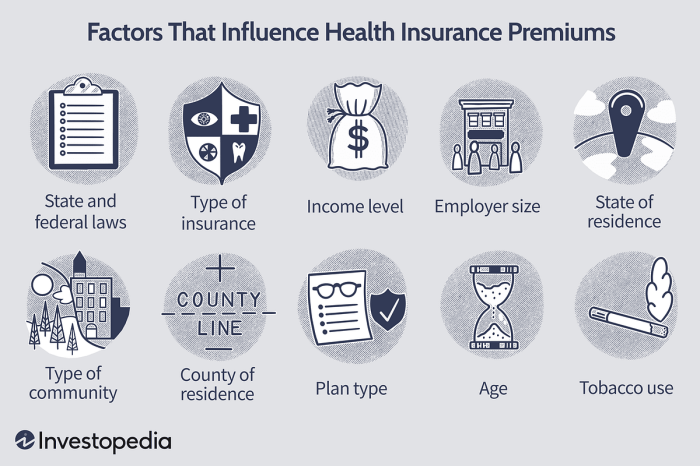The intricate dance between individual healthcare affordability and government intervention is a complex and evolving narrative. This exploration delves into the multifaceted world of US government programs designed to supplement insurance premiums, examining their historical context, current implementation, and future prospects. We will analyze the impact of these subsidies on healthcare access, affordability, and overall health outcomes, considering both intended and unintended consequences.
From the landmark legislation shaping early subsidy programs to the contemporary challenges of budgetary constraints and evolving demographic needs, this analysis provides a nuanced perspective on the role of government support in navigating the complexities of the American healthcare system. We’ll examine the effectiveness of current programs, compare their eligibility requirements, and explore potential alternative models for ensuring affordable healthcare access for all citizens.
Impact of Subsidies on Healthcare Access and Affordability

Premium subsidies significantly influence healthcare access and affordability in the United States. By reducing the out-of-pocket costs for health insurance, these subsidies aim to increase the number of insured individuals and improve the overall health of the population. However, the effects are complex and multifaceted, with both intended and unintended consequences.
The impact of premium subsidies on healthcare access and affordability is a subject of ongoing research and debate. This section will explore the effects of these subsidies on several key areas.
Effect of Subsidies on the Number of Insured Individuals
Premium subsidies have demonstrably increased the number of insured Americans. The Affordable Care Act (ACA), for example, significantly expanded Medicaid eligibility and offered tax credits to individuals purchasing insurance through the marketplaces. Studies have shown a direct correlation between the availability of these subsidies and a reduction in the uninsured rate. For instance, the Kaiser Family Foundation has published numerous reports detailing the substantial increase in insurance coverage following the ACA’s implementation, directly attributable to the expanded subsidies. The magnitude of this effect varies depending on factors such as the generosity of the subsidies and the economic conditions of the population.
Influence of Subsidies on Healthcare Utilization and Costs
Increased insurance coverage due to subsidies leads to higher healthcare utilization. Individuals with insurance are more likely to seek preventative care, routine check-ups, and treatment for illnesses. This increased utilization can lead to both higher healthcare costs and improved health outcomes. However, the extent to which subsidies drive up overall healthcare spending is a complex issue, influenced by factors such as the types of services utilized and the efficiency of the healthcare system. Some studies suggest that while costs increase, the increase is often offset by the prevention of more costly future interventions. For example, early detection of chronic conditions through increased preventative care can prevent more expensive treatments down the line.
Impact of Subsidies on Health Outcomes
While a direct causal link between subsidies and improved health outcomes isn’t always easily established, increased access to care facilitated by subsidies is generally associated with better health outcomes. Studies have shown that improved access to preventative care and treatment leads to better management of chronic conditions, lower mortality rates, and improved overall health status. This positive effect is particularly pronounced among vulnerable populations who previously lacked access to adequate healthcare. For instance, studies have demonstrated a reduction in preventable hospitalizations and improved chronic disease management among populations gaining coverage through ACA subsidies.
Potential Unintended Consequences of Premium Subsidies
The introduction of premium subsidies, while aiming to improve healthcare access and affordability, can have unintended consequences. It is important to acknowledge these potential drawbacks.
- Increased Premiums: Increased demand for health insurance due to subsidies can potentially drive up premiums, offsetting some of the benefits for consumers.
- Moral Hazard: Increased insurance coverage might lead to higher healthcare utilization, even for unnecessary services, resulting in higher overall healthcare spending.
- Adverse Selection: Subsidies may attract a disproportionate number of individuals with pre-existing conditions, potentially leading to higher costs for insurers.
- Reduced Incentive for Cost Containment: The availability of subsidies might reduce the incentive for both individuals and healthcare providers to control costs.
- Administrative Complexity: The design and administration of subsidy programs can be complex, leading to inefficiencies and administrative burdens.
Outcome Summary

Ultimately, the question of US government supplementation of insurance premiums is not merely a matter of fiscal policy; it’s a fundamental question about societal responsibility and the equitable distribution of healthcare resources. While the programs examined offer crucial support to millions, their ongoing effectiveness requires continuous evaluation, adaptation, and a commitment to innovative solutions that address the evolving needs of the population. Further research and ongoing policy dialogue are vital to ensure a sustainable and equitable future for healthcare access in the United States.
Popular Questions
What are the potential long-term financial implications of these subsidy programs?
Long-term financial implications are complex and depend on factors like economic growth, healthcare inflation, and changes in eligibility criteria. Continued expansion could lead to significant budgetary challenges, while reductions could limit access for vulnerable populations. Actuarial studies and ongoing economic forecasting are crucial for informed decision-making.
How do these subsidies affect healthcare providers?
Subsidies can indirectly impact healthcare providers by influencing patient volume and the types of services demanded. Increased access due to subsidies might lead to higher patient loads, while changes in eligibility criteria could shift the patient demographic served. The effect on provider reimbursement rates and overall financial stability varies depending on the specific program and provider type.
Are there any private sector initiatives that complement government subsidy programs?
Yes, several private sector initiatives, such as charitable foundations and employer-sponsored health programs, complement government efforts. These often focus on specific populations or geographic areas and may provide additional financial assistance or support services. The coordination between these private and public efforts is crucial for maximizing impact.